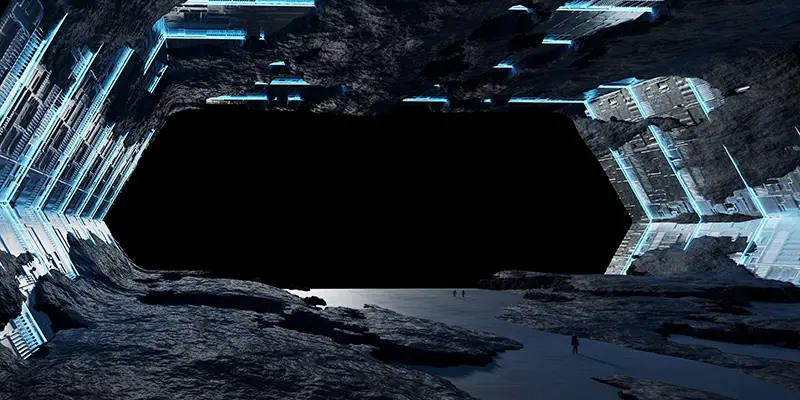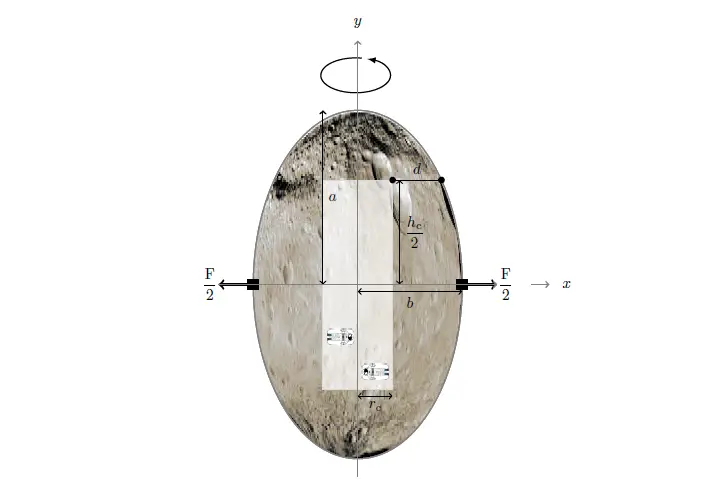
15th February 2019 Asteroid mining colonies are technically feasible Researchers conclude that a hypothetical 500-metre asteroid with its interior hollowed out could provide suitable conditions for a mining colony.
Asteroid mining is predicted to become a reality in the not-too-distant future, as the first tentative prospecting and extracting operations are conducted by government agencies and commercial interests. Given the enormous abundance of raw materials out there in our Solar System, it has the potential to grow into a multi-trillion dollar industry in the centuries ahead. It might be relatively easy to land on a small body and gather materials from its surface, using current or near-term technology. However, going much deeper inside the rock – perhaps to uncover rarer and more valuable commodities – would be an entirely more difficult task. Far future colonies built from hollowed-out interiors of asteroids are featured in science fiction, such as Kim Stanley Robinson's 2312 and the video game Elite: Dangerous, but how feasible are these? Astrophysicists at the University of Vienna, Austria, have released new research on the preprint server ArXiv, in which they claim that a slowly-spinning asteroid in the 100 to 500m size range could be mined from the inside out. Centrifugal forces within the gradually developing cavern would provide enough gravity for mining equipment to be effectively used. This is as opposed to drilling on the microgravity surface outside, where tools would be pushed away from the rock when exerting a force and therefore be more difficult to control. Using advanced gravity models, the researchers' paper describes the "optimal" asteroid for successful mining operations. They calculate that it would need to be made of solid stone and spin between one and three times a minute, creating an interior gravity of 0.38 G, which is 38% of Earth's gravity and the same as Mars. In addition, the researchers speculate on the potential for such an asteroid to be inhabited by humans. As shown in the diagram below, they note that a cylindrical interior could be used to house a space station, while the remaining outer shell could offer protection from cosmic radiation. If the spinning movement was maintained and the overall stability was carefully monitored, the resulting gravity would also improve occupants' long-term health compared to zero-G.
Credit: Thomas I. Maindl, et al.
In 2312 (the year in which the book is set), humans are settled across the Solar System with habitats that include many "terrariums" – artificial ecosystems placed in the cylindrically-shaped interiors of asteroids. These hollow spaces are crafted by self-replicating machine excavators, then sealed to prevent exposure to the vacuum of space. Atmospheric gases, water, sand, soil and other features are gradually added, followed by living biomes. A lighting element forms a central "spine" along the axis of rotation to provide artificial light. The lit part of the line travels the length of the cylinder to simulate the Sun's path over Earth's sky. During the night phase, street lights on the inner surface overhead resemble stars. The novel's author, Kim Stanley Robinson, writes about the infinite possibilities for terraria ecosystems, e.g. water worlds with entirely liquid interiors for housing marine species; as well as genetically engineered ecospheres or habitats with new species. Terraria are not only created for residential purposes; they also function as farming worlds (producing food for Earth) and giant transportation vessels. Meanwhile, the video game Elite: Dangerous – set in the year 3305 – includes a number of distant asteroid bases that are mostly to be found on the outskirts of human-inhabited space, such as in the Orion and California nebulae. After a long journey, players can approach these huge rocks and contact station personnel to request docking permission, before flying their ships through a pressurised entrance to an assigned landing pad. The game's visual artists have created an "unfinished" look to the station interiors, evoking a sense of the work and effort involved in excavating such a vast amount of rock. The asteroid colonies in both 2312 and Elite: Dangerous are much bigger than those in the University of Vienna's study, but they offer a tantalising glimpse of what the far future may bring. For now, we know that smaller-scale versions are, in theory at least, technically feasible. "The border between science and science fiction here is sort of blurry," said Thomas Maindl, discussing his team's paper with New Scientist. "My gut feeling is that it will be at least 20 years before any asteroid mining happens, let alone something like this."
Comments »
If you enjoyed this article, please consider sharing it:
|








